Ghost Island Affair
by: Lynn E. McElfresh
The North Country is a cold, lonely place in the first few months of the year. Back in the 1920s, only a handful of people lived year-round on Grenell Island. The permanent population of Grindstone Island by 1920 had dwindled to about one hundred hearty souls. Once islanders left the mainland, they left the 20th century behind. It was a hardscrabble life. No electricity. No phones. When the River froze solid, islanders could walk, skate or drive to the mainland. But as the ice began breaking up in March and April, trips to the mainland became precarious or impossible. The month of March on the islands must have been cold, lonely, and perhaps mundane. But there was nothing mundane about March 1928. That year the world came to the islands as a mystery unfolded.
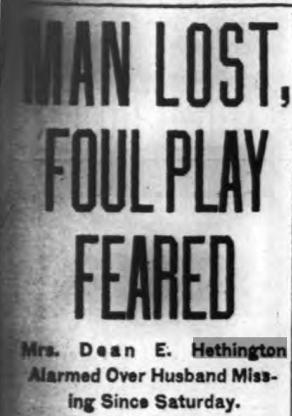
MISSING! DEAN HETHINGTON, STEEL EXECUTIVE
Islanders were probably first alerted that something was amiss when they noticed a low-flying Stinson-Detroiter bi-plane named the H2Otown, crisscrossing the River between Clayton, New York, and Gananoque, Ontario. It was an unusually clear day; both the pilot and the islanders below could see for miles up and down the River.
News spread quickly. Authorities were hunting for a Syracuse man, Dean Hethington, a steel executive of Globe Forge and Foundries, Inc., who had been missing for nearly three weeks. He’d told his wife he was going to Binghamton on business and would be back the next day. Detective Lynch, from the Syracuse Detective Bureau, started the search in Binghamton only to find that Hethington never arrived, in fact, he didn’t even have an appointment. Foul play was suspected, though Lynch hadn’t ruled-out an accident. Perhaps Hethington had met with an accident and had amnesia.
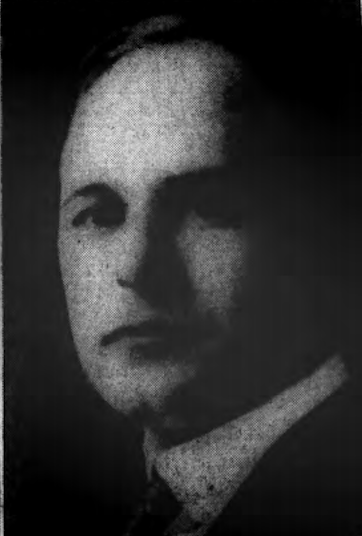
MARCH 15th, 1928—FIRST CLUES ARE FOUND IN CLAYTON, NY
After receiving a mysterious phone call from Gananoque, Detective Lynch headed north to Clayton, New York, accompanied by Hethington’s brother-in-law, William Drexler. There, the duo found the first trace of the missing steel executive. Yes, locals told Lynch, they’d seen a man in a navy blue suit, maroon tie, and a black derby hat. He’d had dinner in Clayton, and he wasn’t alone. He was with an attractive woman and they were talking about going to Gananoque. In fact, they had asked the best way to get there—over the ice.
Back in 1928, there was no bridge between New York and Ontario. If Hethington wanted to go to Gananoque, he had to go over the ice. Had Hethington and his mysterious companion driven across the ice? First, Lynch checked all the garages in Clayton, for Hethington’s black Hudson; not finding it, he and Clayton police chief Arnold J. Knight enlisted the help of Allen Percy to guide them across the ice to Grindstone Island.
Walking in a single file six feet apart, the trio moved slowly and carefully over the ice. Lynch slipped and slid as much as he walked. Allen was in the lead with a long pike pole, poking and prodding the ice ahead of them, testing its viability. Once, the length of the pike pole almost disappeared through the ice, and water bubbled-up through what had seemed a solid piece of ice. Percy stopped, backtracked, and found safe passage around the “rotten ice.”
Once they walked the mile and a half across the River to Grindstone Island, Lynch, and Arnold showed Hethington’s picture to islanders and described Hethington’s Hudson. Florence Garnsey remembered the car. The driver had asked the best way to cross the island and she’d pointed out the way. Florence told Lynch and Knight that he was with a woman, an attractive brunette wearing a nice coat with a fox collar. The news was encouraging. Lynch thought that perhaps he was close to finding the missing steel executive, but it was nearly dusk. Leary of crossing the ice in the dark, the duo stayed overnight at the home of Robert Garnsey, on Grindstone Island. Tomorrow they would resume the search. Hopefully, with any luck, they would find Hethington somewhere on Grindstone Island.
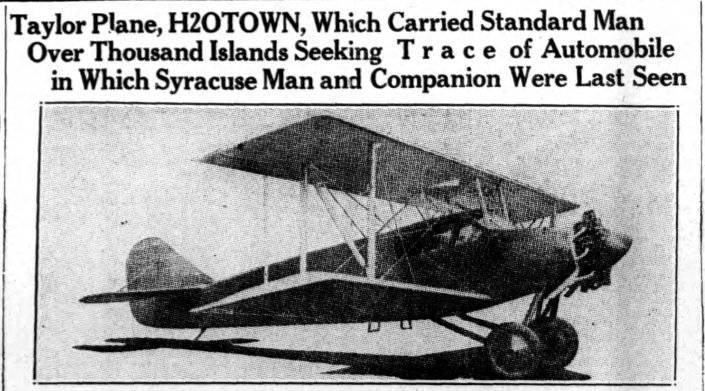
MARCH 16th GRINDSTONE ISLAND -- THE SEARCH CONTINUES
Early the next morning, Lynch and Knight continued to question Grindstone Island residents. Anna Goodwin also remembered the car. The driver wanted to know the best way to cross the ice to Gananoque. Anna advised him against crossing the River. Two cars had gone through the ice the week before. She did not tell the authorities that a horse-drawn sleigh loaded with beer also went through the ice—this was during Prohibition. Luckily, all the occupants and even the horse had escaped drowning. Anna stressed that crossing without an experienced guide was extremely dangerous. But Hethington insisted, so Anna pointed out the way. It was dusk on February 25th and getting darker as Hethington and his companion pulled out onto the ice. Anna stood on the shore for some time and watched the car as it zoomed away from the shoreline—not slowly, not cautiously—but at breakneck speed. Other residents who saw the car said it was traveling around 60 miles an hour. (Average highway speed in the 1920s was around 40 mph.) At one point, Hethington lost control and the car fishtailed and skidded. Now, seemingly confused, Hethington was headed in the wrong direction. He was headed for the Leek Island channel. Horrified, Anna squinted into the growing darkness as the dark sedan disappeared from sight. She had no idea if the car made it across the ice or disappeared below it.
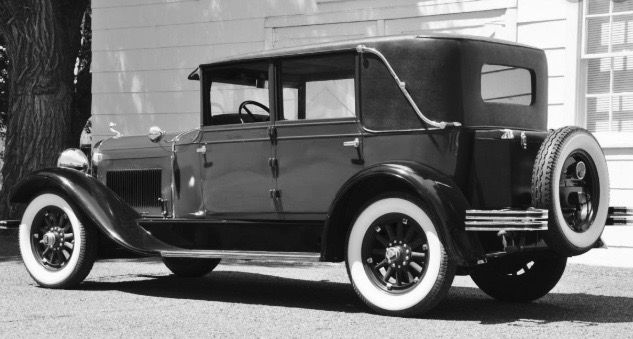
Next, Lynch and Knight interviewed sixteen-year-old Will Foust. Foust also saw Hethington leave Grindstone Island the evening of February 25th. The next morning, Foust strapped on ice skates and followed the car tracks. He told Lynch and Drexler the tracks ended at a patch of open water off Ghost Island. That had been weeks ago. The thaw and the two days of rain had erased all evidence of the car tracks, but young Foust thought he might be able to lead the authorities to the spot. Ice conditions were even more precarious. Aided by local Grindstone Island guides, Gerald and Leon Rusho, the group ventured out onto the ice.
Again, walking in single file, they moved cautiously across the treacherous ice toward Ghost Island, as Chief Knight dragged a grappling line behind him. The ice was now pitted with air holes and could weaken at any time. The guides prodded the ice with long iron poles carefully circling around danger spots until at last they found safety on Ghost Island and peered at the gaping hole in the ice just beyond its shore.
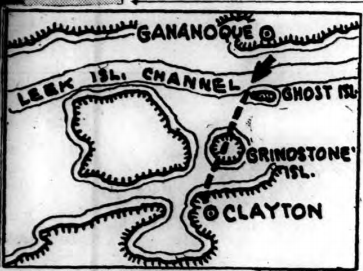
THE LEEK ISLAND CHANNEL & GHOST ISLAND
Grindstone Islanders explained that the waters of Leek Island channel were treacherous. The current here was so strong that sometimes ice never formed. Even in the coldest weather, the ice was very thin and often not thick enough to support a pedestrian. Perhaps the swift current is the reason that so many tragedies happen around Ghost Island, a dot of an island near Hay and Leek Islands. [Today, Leek Island is known as Thwartway Island.] Others say it’s not the current; the island is haunted. Stories of death and doom surround the island. A hundred years before, sailors on a schooner sailing between Kingston and Prescott were overcome with cholera. Legend has it that they died and were buried on Ghost Island. Yet another tale tells of a box of body parts was found on the island in the 1880s. The unidentified body had been buried on the island. Locals claimed phantoms roam the island. Tragedy seemed to surround it. Once a government barge moored near the island exploded for no apparent reason, killing the entire crew. Another time, a barge of cattle and its owner went missing near the island, never seen again. In 1926, a barge sank in almost the same spot they were looking for the Hethington sedan.
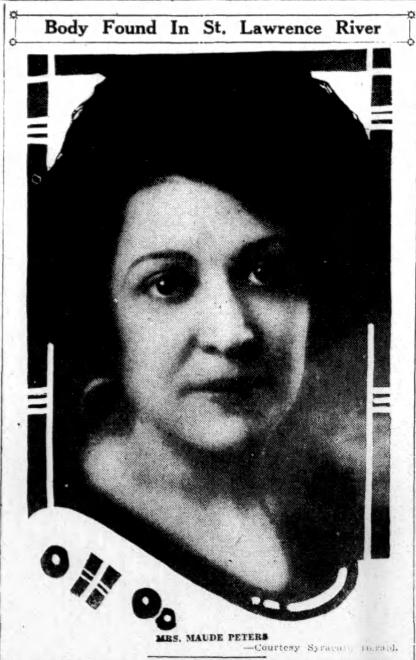
GRINDSTONE ISLANDERS RALLY TO HELP
Over thirty Grindstone islanders volunteered to help in the search. Because of the poor condition of the ice, sleighs were pressed into service to transport equipment from Slate Marina. Volunteers slid ice punts across the ice and into the open waters near Ghost Island. Dozens more ice skated to Ghost Island to watch the drama unfold from the safety of the shore.
After several hours of dragging the River bottom with grappling hooks, someone hit something solid. There was paint on the grappling hook when they brought it to the surface. Was it the Hethington sedan or the barge that sank there last year? Lynch summoned a diver from Alexandria Bay.
It was late in the day when Robert Crary donned a deep-sea diver’s suit and helmet and slipped over the side of the ice punt into the rushing current of the Leek Island channel. The water was freezing and there was always the danger of being swept to his death under the ice. Above, in the ice punt a pair of men hung onto a rope tied around Crary and struggled to keep his air hose from getting tangled. Ten minutes after Crary went down there were frantic pulls on the rope. Clearly, Crary was in trouble. The men frantically hauled up the rope and pulled Crary from the icy waters of the St. Lawrence. Unbeknownst to Crary, there was a tear in his diver’s suit. It had filled with water and nearly drowned him. The search was called off for the day. Crary was given warm clothing and assisted back to Clayton. The search would resume tomorrow.
WAS IT ALL A RUSE?
The search party carefully plodded the two miles back to Grindstone over the ice and pondered the events of the day. By now, the identity of the mystery woman had come to surface. Mrs. Maude L. Peters was a divorcee who had once been Hethington’s stenographer. Rumors flourished that she had been carrying $10,000 of jewels in her handbag. When it was revealed that Maude had lived in Gananoque when she was younger, speculation spread among the islanders like wildfire. If she were from Gananoque, she would have known about the treacherous spot off of Ghost Island. Perhaps the reason the car was speeding out of control was that no one was driving it. Perhaps it was all a ruse. Was it possible that the couple had exited the vehicle, put a brick on the accelerator, and let it go? When the car was recovered in the spring, the bodies would be gone and the love birds would have disappeared to Canada with $10,000 in jewels to fund their new life together.
MARCH 17th—THE SEARCH RESUMES
The next day, an oil slick on the water attracted searchers’ attention. Around 11 o’clock the next day, they saw what they thought was the top of the sedan about forty-feet from the shore of Ghost Island. They lowered a ladder to the roof of the car. Wearing his heavy dive helmet and borrowed dive suit, diver Robert Crary climbed down the ladder onto the roof of the sedan. He returned to the surface four minutes later with Hethington’s coat in his hands. There was a body in the backseat of the sedan. He couldn’t get inside the car because his air hose got tangled with the car. Crary made seven more dives that day, spending only a few minutes in the freezing water at a time. It was on the fourth dive that brought up the body of Mr. Hethington. On the fifth dive, Crary bought up Mrs. Peter’s handbag. The sixth and seventh dives were fruitless. There was no sign of Mrs. Peters.
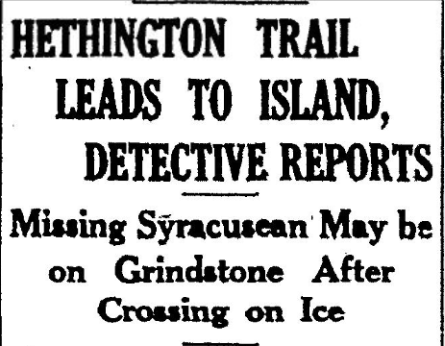
Lynch sent volunteers to fetch the coroner from Gananoque and sent Gerald and Leon Rusho and four reporters to Clayton with the news. The Rushos and reporters walked back to Grindstone and made the second leg of the trip across Grindstone in a car and then drove across the ice to Clayton. Gerald drove and Leon stood on the running board with keen eyes focused on the ice. There was no top on the car and they drove with all four doors open—just in case. It was a herky-jerky trip as Gerald navigated around rotten ice. Sometimes the car splashed through a layer of water two or three inches deep. Other times there was an alarming crunch and crackle as a thin layer of ice gave way. At one point, the Rusho brothers suggested the reporters get out and walk behind the vehicle as it crept across a dangerous spot.
Meanwhile, back at Ghost Island, volunteers pulled the sedan from the icy waters. Harold Bertrand, proprietor from the Herald House and Randolph Parker, also from Clayton, took charge of the salvage effort. Equipment had been brought over from Slate Marina on Grindstone. Using a block and tackle and with the force of one hundred men, the Hudson sedan was dragged from the bottom onto the shore. They had hoped to find Mrs. Peter’s body in the car, but it was empty. Once the car was raised, the volunteers made fires on the shore of Ghost Island and kept vigil over the body and the wrecked Hudson as they waited for the coroner.
It was nearly dark, by the time coroner from Gananoque gave permission for the body to be removed from Canadian territory to U.S. soil. Hethington’s body was loaded onto an ice punt. Guided by kerosene lanterns in the growing darkness, the search party trudged back to Grindstone. After crossing Grindstone by vehicle, the body was transferred back to an ice punt. Leaving the Grindstone volunteers behind, Lynch, Drexler and a handful of Clayton volunteers started across the ice toward Clayton pulling Hethington’s body behind them.
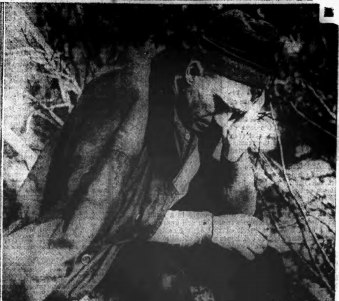
Three times Drexler nearly met the same fate as his brother-in-law when the ice he was standing on gave way and he started to sink. Each time a Clayton volunteer was there to pull him onto strong ice. George Hutchinson, a Clayton Merchant, wasn’t as lucky. He slipped under the ice. His business partner, Harry Patterson, was there to pull him out of the water. He was unconscious. They rushed George to the Clayton dock and sent for a pulmantor—a respiratory apparatus for pumping air into and out of the lungs was sent for. After an hour on the apparatus, George was revived. A happy ending to a long day.
MARCH 18th—BLIZZARD AND EARTHQUAKE
The next morning, the north country woke to the worst blizzard of the winter. Lynch decided to wait out the storm at Herald House, but a hearty trio of Grindstone Islanders braved the blizzard and continued the search. They trudged across the frozen River with their ice punt in tow, then launched the punt in the open water off of Ghost Island. Frank Slate and his sixteen-year-old son, Frank Jr. held the grappling hook while Erwin Turcott rowed. For four hours the three dragged the rocky River bed. At 1 o’clock, Frank, Sr. felt a tug. They were about 200-feet downstream from where the car had been located. When Frank hauled in the line he found a small piece of cloth on his hook, which he figured was from a woman’s skirt. Turcott turned the punt around and rowed back to the spot. This time the hook caught and held. The pair pulled the body of Mrs. Maude Peters to the surface and hauled it into the boat. Frank sent Frank, Jr. to inform the authorities. It took the sixteen-year-old more than two hours to cross the ice in the blizzard. Unable to see far ahead, he had to move slowly, cautiously.
Immediately upon receipt of the news, Lynch, Drexler, Olin Pernie, Nelson Langton, and Robert Garnsey set out for Ghost Island. Word was sent to have a funeral director from Gananoque to retrieve the body.
As if the raging blizzard wasn’t enough, a small earthquake rocked the St. Lawrence River valley. It was snowing hard and visibility was low when Detective Lynch felt the ice tip-up and a huge fissure opened at his feet. Lynch tried to regain his balance, but slipped and fell in. He hung onto the edge of the ice and Robert Garnsey grabbed him from under the armpits and hauled him back to safety. From there, Lynch made it to the scene. The body was identified by Florence Garnsey as the woman she had seen with Hethington.
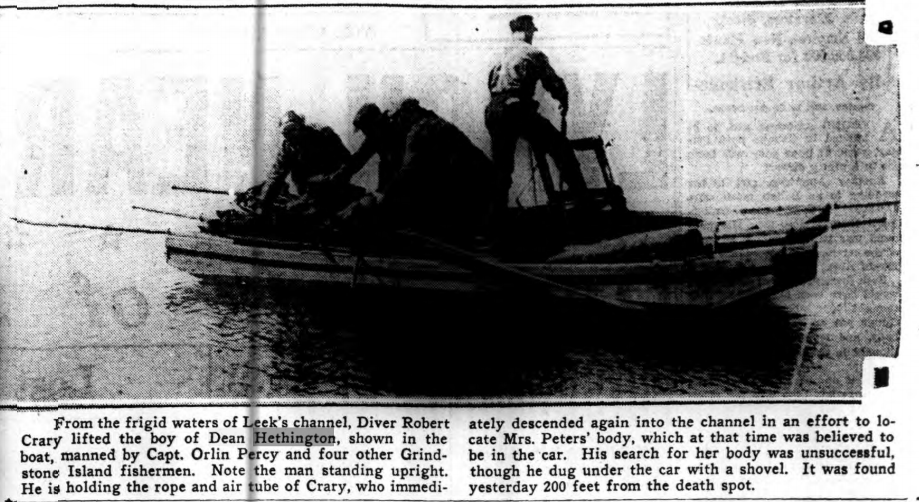
The mystery was over. The couple who had set-off the night of February 25th to visit friends in Gananoque had been found. When they hadn’t arrived at their friend’s home at the appointed time, their friend had thought perhaps they had changed their minds. But when he read the news in the newspapers that Hethington was missing he contacted authorities in Syracuse.
Lynch and Drexler returned to Syracuse that evening with the body. Mrs. Peter’s body was sent to her home town in Canada for burial. While their graves are separated by the international border, they will forever be linked to the mystery surrounding Ghost Island.
By Lynn E. McElfresh
Usually at this time of year you can find Lynn McElfresh and her husband Gary, exploring the world, but this year their excursion to Asia was cut short and we are pleased to report they are sheltered at home in Dunedin, Florida.
Lynn has written well over 130 articles for TI Life and each one makes this editor happy and entertains TI Life readers. This one is no exception. To see all of Lynn’s island experiences, search TI Life under Lynn McElfresh.
And as an added bonus, a few months ago, we announced Lynn's first of nine novels... Grenell 1881, Her second novel is about to be published, and being "safe at home," we suspect she is working on Novel 3.
Grenell 1881 is now on sale in several River locations. Buy it, read it and enjoy it!
See our TI Life Review, written by Janet Staples.


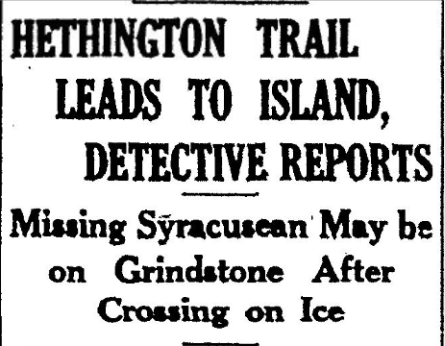



Please click here if you are unable to post your comment.